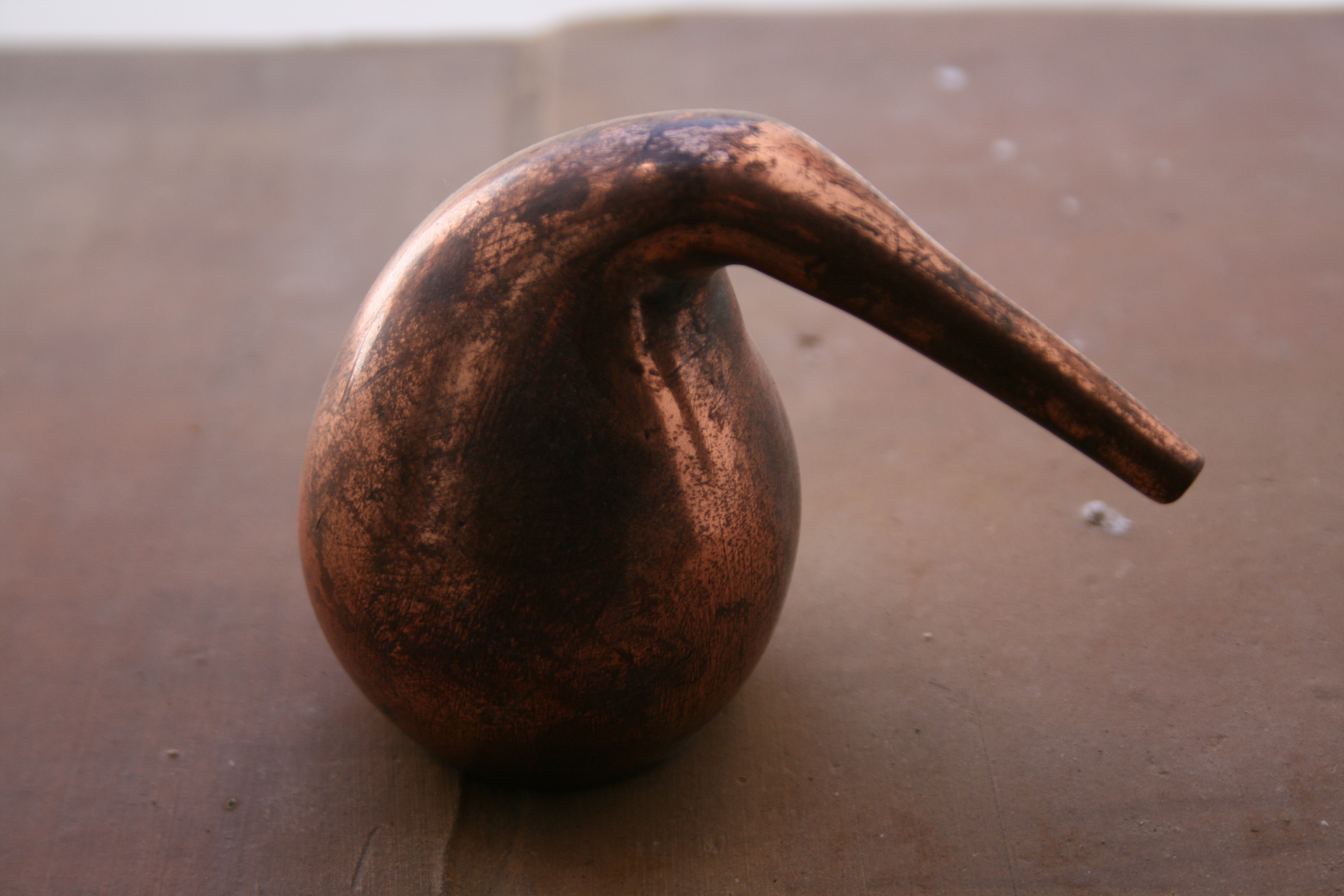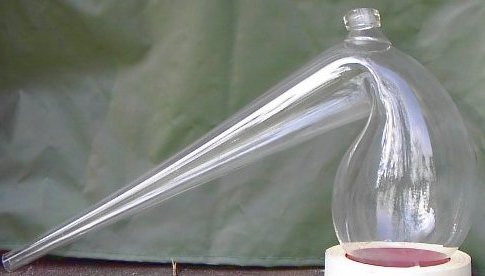Retort on:
[Wikipedia]
[Google]
[Amazon]

 In a chemistry laboratory, a retort is a device used for
In a chemistry laboratory, a retort is a device used for

 In a chemistry laboratory, a retort is a device used for
In a chemistry laboratory, a retort is a device used for distillation
Distillation, or classical distillation, is the process of separating the components or substances from a liquid mixture by using selective boiling and condensation, usually inside an apparatus known as a still. Dry distillation is the heat ...
or dry distillation
Dry distillation is the heating of solid materials to produce gaseous products (which may condense into liquids or solids). The method may involve pyrolysis or thermolysis, or it may not (for instance, a simple mixture of ice and glass could be s ...
of substances. It consists of a spherical
A sphere () is a geometrical object that is a three-dimensional analogue to a two-dimensional circle. A sphere is the set of points that are all at the same distance from a given point in three-dimensional space.. That given point is the ce ...
vessel with a long downward-pointing neck. The liquid to be distilled is placed in the vessel and heated. The neck acts as a condenser, allowing the vapors to condense and flow along the neck to a collection vessel placed underneath.
In the chemical industry, a retort is an airtight vessel in which substances are heated for a chemical reaction producing gaseous products to be collected in a collection vessel or for further processing. Such industrial-scale retorts are used in shale oil extraction
Shale oil extraction is an industrial process for unconventional oil production. This process converts kerogen in oil shale into shale oil by pyrolysis, hydrogenation, or thermal dissolution. The resultant shale oil is used as fuel oil or up ...
, the production of charcoal and in the recovery of mercury in gold mining processes and hazardous waste. A process of heating oil shale
Oil shale is an organic-rich fine-grained sedimentary rock containing kerogen (a solid mixture of organic chemical compounds) from which liquid hydrocarbons can be produced. In addition to kerogen, general composition of oil shales constitut ...
to produce shale oil
Shale oil is an unconventional oil produced from oil shale rock fragments by pyrolysis, hydrogenation, or thermal dissolution. These processes convert the organic matter within the rock (kerogen) into synthetic oil and gas. The resulting oil c ...
, oil shale gas Oil shale gas (also: retort gas or retorting gas) is a synthetic non-condensable gas mixture (syngas) produced by oil shale thermal processing (pyrolysis). Although often referred to as shale gas, it differs from the natural gas produced from shale ...
, and spent shale is commonly called retorting. Airtight vessels to apply pressure as well as heat are called autoclaves.
In the food industry, pressure cookers
Pressure cooking is the process of cooking food under high pressure steam and water or a water-based cooking liquid, in a sealed vessel known as a ''pressure cooker''. High pressure limits boiling, and creates higher cooking temperatures which c ...
are often referred to as retorts, meaning " canning retorts", for sterilization under high temperature (116–130 °C).
History
Retorts were widely used by alchemists, and images of retorts appear in many drawings and sketches of their laboratories. Before the advent of modern condensers, retorts were used by many prominent chemists, such asAntoine Lavoisier
Antoine-Laurent de Lavoisier ( , ; ; 26 August 17438 May 1794),
CNRS (
CNRS (
Jöns Berzelius
Jöns is a Swedish given name and a surname.
Notable people with the given name include:
* Jöns Jacob Berzelius (1779–1848), Swedish chemist
* Jöns Budde (1435–1495), Franciscan friar from the Brigittine monastery in NaantaliVallis Grati ...
.
The earliest known use was by Islamic golden age chemist and philosopher Jabir ibn Hayyan
Abū Mūsā Jābir ibn Ḥayyān (Arabic: , variously called al-Ṣūfī, al-Azdī, al-Kūfī, or al-Ṭūsī), died 806−816, is the purported author of an enormous number and variety of works in Arabic, often called the Jabirian corpus. The ...
c. one thousand years before European chemists.
An early method for producing phosphorus
Phosphorus is a chemical element with the symbol P and atomic number 15. Elemental phosphorus exists in two major forms, white phosphorus and red phosphorus, but because it is highly reactive, phosphorus is never found as a free element on Ear ...
starts by roasting bones, and uses clay retorts encased in a very hot brick furnace to distill out the highly toxic product.
The term ''retort'' comes by way of Middle French
Middle French (french: moyen français) is a historical division of the French language that covers the period from the 14th to the 16th century. It is a period of transition during which:
* the French language became clearly distinguished from ...
, but ultimately from Latin
Latin (, or , ) is a classical language belonging to the Italic branch of the Indo-European languages. Latin was originally a dialect spoken in the lower Tiber area (then known as Latium) around present-day Rome, but through the power of the ...
''retortus'', twisted back, for the shape of the neck.
Role in analytical chemistry
Inlaboratory
A laboratory (; ; colloquially lab) is a facility that provides controlled conditions in which scientific or technological research, experiments, and measurement may be performed. Laboratory services are provided in a variety of settings: physic ...
use, due to advances in technology, especially the invention of the Liebig condenser
The Liebig condenser (, ) or straight condenser is a piece of laboratory equipment, specifically a condenser consisting of a straight glass tube surrounded by a water jacket.
In typical laboratory operation, such as distillation, the condenser ...
, retorts were largely considered to have been rendered obsolete as early as the beginning of the 20th century. However, some laboratory techniques
A laboratory (; ; colloquially lab) is a facility that provides controlled conditions in which scientific or technological research, experiments, and measurement may be performed. Laboratory services are provided in a variety of settings: physici ...
that involve simple distillation and do not require sophisticated apparatus may use a retort as a substitute for more complex distillation equipment.
In biochar-pyrolysis industry
A retort is a reactor that has the ability to pyrolyze pile-wood, or wood logs over long and up to in diameter.Emrich, W. 'Handbook of Charcoal Making, the Traditional and Industrial Methods'. D. Reidel Pub. Co., Hingham, MA, 1985, p 296See also
* Alembic * Retort pouch *Retort stand
In chemistry, a retort stand, also called a clamp stand,Laboratory-Equipment.com (2020):Large Clamp Stand, for Q700. Online catalog item 5323-07. Accessed on 202-02-18. a ring stand, or a support stand,Fischer Scientific (2020):American Education ...
References
External links
* {{Laboratory equipment Alchemical tools Laboratory glassware